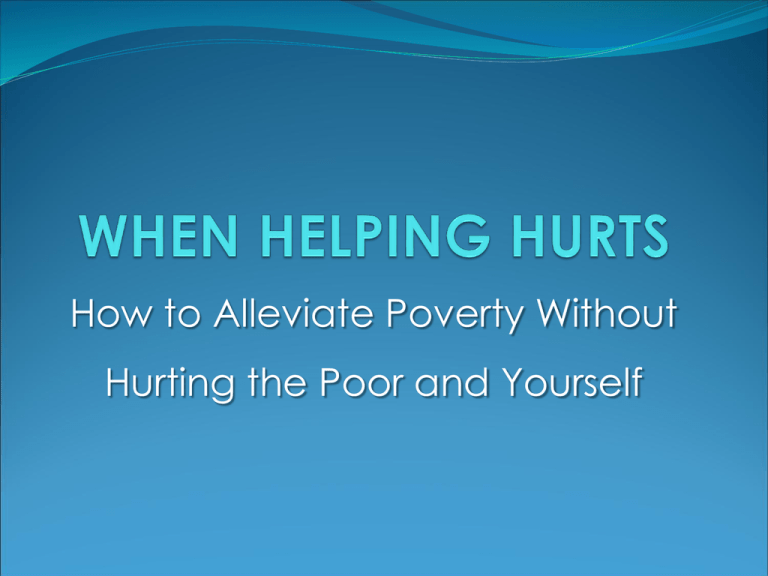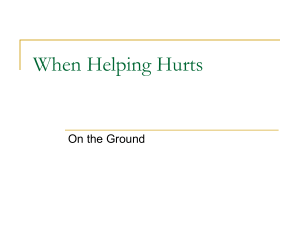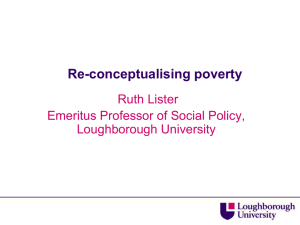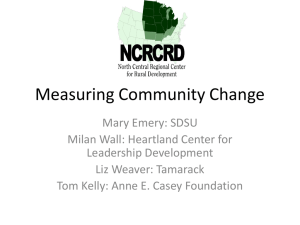
How to Alleviate Poverty Without
Hurting the Poor and Yourself
Why did Jesus come to earth?
“The Spirit of the Lord is on me, because he has anointed
me to preach the good news to the poor. He has sent me
to proclaim freedom for the prisoners and recovery of sight
for the blind, to release the oppressed, to proclaim the year
of the Lord’s favor,”…
“I must preach the good news of the kingdom of God to
the other towns also, because that is why I was sent”
Jesus is the Creator, Sustainer, and Reconciler of everything.
What is the task of the church?
Jesus preached the good news of the kingdom in word and in
deed, so the church must do the same.
“There should be no poor among you.” God declared (Deut. 15:4)
But Israel did not fulfill its task.
The church should be the very fulfillment of Christ (Eph 1:18-23; 4:7;
5:32).
His Kingdom, a kingdom in which there is no poverty (Rev. 21:1-4)
Throughout the New Testament care of the poor is a central
concern of the church. (Matt. 25:31-46; Acts 6:1-7; Gal 2:1-10: 6:10;
James 1:27)
Disciple's Observations
“Listen, my brothers: has not God chosen those who are poor in the
eyes of the world to be rich in faith and to inherit the kingdom he
promised those who love him?” (James 2:5)
Paul makes his point in his letter to the Corinthian church when he says:
Brother, think of what you were when you were called. Not many of
you were wise by human standards; not many were influential; not
many were of noble birth. But God choose the foolish things of the
world to shame the wise; God chose the weak things of the world to
shame the strong. He chooses the lowly things of this world and the
despised things – and the things that are not – to nullify the things that
are, so that no one may boast before him. (1 Cor. 1:26-29)
Not an exclusive task to the church
The Bible teaches that the local church must care for the
spiritual and physical needs of the poor; however the Bible
does not indicate that only the local church is responsible.
Direct Intervention
Indirect Intervention
Wisdom must be used to determine the best course of
action in each situation.
What are the Perceptions of Poverty?
Western perception of being poor: lack of material things such
as food, money, clean water, and housing.
While poor people mention having a lack of material things,
they tend to describe their condition if far more psychological
and social terms. Poor people typically talk in terms of shame,
inferiority, powerlessness, humiliation, fear, hopelessness,
depression, social isolation, and noiselessness.
The mismatch of understanding can have devastating
consequences on poverty alleviation efforts.
A Biblical Framework
Being made in the image of God, human beings are inherently
relational as well. These relationships are the building blocks for
all of life.
For our purposes, when these relationships are functioning
properly. People are able to fulfill their callings of glorifying God
by working and supporting themselves and their families with
the fruit of their work.
Relationship with God:
This is our primary relationship to glorify God and enjoy Him
forever. This is our calling the ultimate reason for which we
were created. We were created to serve and give praise to
our Creator through our thoughts, words, and actions giving
us a joyful intimate relationship with Him as His children.
Relationship with Self:
People are uniquely created in the image of God and thus
have inherent worth and dignity. While we must remember
that we are not God, we have a high calling of reflecting
God’s being making us superior to the rest of creation.
Relationship with Others:
God created us to live in loving relationship with one
another. We are not islands! We are made to know one
another, to love one another, and to encourage one
another to use the gifts God has given to each of us to fulfill
our callings.
Relationship with the rest of Creation:
The "cultural mandate" of Genesis 1:28-30 teaches that God
created us to be stewards, people who understand, so do,
and manage the world that God has created in order to
produce bounty. Note that while God made the world
perfect, he left it incomplete. This means that while the world
was created to be without defect, God calls humans to
interact with creation, to make possibilities into realities, and
to be able to sustain ourselves with the fruits of our
stewardship.
People affect systems, and
systems affect people.
Who are the Poor?
When Helping Hurts:
One of the major premises we need to embrace is our mutual
brokenness, our work with low-income people is likely to do far
more harm than good. As discussed earlier researchers found
from around the world that shame a poverty of being is major
partner in brokenness for low income people's experience in
their relationship with themselves. Instead of seeing themselves
as being created in the image of God, low income people
often feel there inferior to others. This can paralyze the poor
from taking initiative and from seizing opportunities to improve
their situation, thereby locking them into material poverty.
What can be done to change the
equation?
Changing the first term in this equation requires a revised understanding of
the nature poverty. North American Christians need to overcome the
materialism of western culture and see poverty and more relational terms.
Changing the second term in this equation requires ongoing repentance. It
requires North American Christians to understand the brokenness and to
embrace the message of the cross in deep and profound ways, saying to
ourselves every day: I am not okay; and you are not okay; but Jesus can fix
both as we do this, God can use us to change the third term of the equation.
By showing low-income people through our words, our actions, and most
importantly our ears that they are people with unique gifts and abilities, we
can be part of helping them to recover their sense of dignity, even as we
recover from our sense of pride.
Spider Web Effect!
Are we there yet?
We need to have a clear concept of success if we want to
have any hope of getting their, just our diagnosis of the calls
of poverty shapes the remedies we pursue, so too does our
conception of the ultimate goal.
How can your church or ministry help to alleviate poverty for
people?
What does success look like?
How should we then alleviate?
We are therefore Christ's ambassadors, as though God were
making his appeal through us. We implore you on Christ's
behalf: be reconciled to God (2 Corinthians 5:18-20)
We are not the reconciler; Jesus is.
Reconciliation of the relationships is the guiding compass for
our poverty-alleviation efforts, profoundly shaping both the
goals that we pursue and the methods we use.
The Goal is Not!
To make the materially poor all over the world in the middle-
to upper class North Americans, a group characterized by
high rates of divorce, sex addiction, substance abuse, and
mental illness.
Nor is it the goal to make sure that the materially poor have
enough money.
Two Keys:
First, material poverty alleviation involves more than ensuring that people
have sufficient material things; rather, it involves a much harder task of
and about empowering people to earn sufficient material things to their
own labor, for in doing so we moved people to being closer to why God
created them to be. Of course we recognize that is impossible for some
people because of disability or other factors.
Second, work is an act of worship. When people seek to fulfill their callings
by glorifying God in their work, praising him for their gifts and abilities, and
sees both their efforts in its product as an offering to him, then work is an
act of worship to God. On the other hand, when work is done to glorify
oneself or merely to achieve more wealth, it becomes worship of false
gods. How we work and for whom we work really matters.
The Reconciliation Perspective:
The reconciliation perspective has major implications for
how we choose, design, implement, and evaluate our
efforts. Our perspective should be less about how were
going to fix the materially poor and more about how we can
walk together, asking God to fix both of us.
Poverty alleviation occurs when the power of Christ
resurrection reconciles our key relationships through the
transformation of both individual lives and local, national,
and international systems.
People and Processes, not Projects
and Products:
The goal is to see people restored to being one God created
them to be: people who understand that they are created in
the image of God with gifts, abilities, and the capacity to
make decisions to affect change in the world around them;
and people who steward their lives, communities, resources,
and relationship in order to bring glory to God.
These things tend to happen in highly relational, process-
focused ministries more than impersonal, product-focused
ministries.
Distorted Worldview:
The worldview that dominates and in many regions of the majority
the world, is unpredictable spirits control the rest of creation,
implying that creation is chaotic and uncontrolled by humans. This
can lead to fatalism that prevents people from exercising
dominion in improving their material well-being. Faulty worldviews
can be key obstacles, implying that the worldview transformation
must often play a central role in poverty-alleviation efforts. In fact,
in some cases people's worldviews are so distorted it is difficult to
bring about any progress at all until people undergo a major
paradigm shift.
Dangers in the 21st Century:
All of us have been heavily influenced by the modern
worldview, which believes that human reason and effort are
able to understand and control the material world without
the need for understanding or relying upon God. As a result,
we are very prone to putting our trust in ourselves and in
technology to improve our lives, forgetting that it is God who
is the creator and sustainer of us and of the laws that make
our technology work.
What does the situation call for?
Relief
Rehabilitation
Development
It is absolutely crucial that we determine whether relief,
rehabilitation, or development is the appropriate
intervention: one of the biggest mistakes that North
American churches make-by far-is in applying relief to a
situation in which rehabilitation or development is the
appropriate intervention.
How do you spell Relief?
Seldom, Immediate, and Temporary
Once relief efforts have stopped the bleeding, it's time to move
quickly to rehabilitation, working with, not for, people to help
them return to the positive elements of their pre-crisis
conditions.
Rehabilitation must be done in a way consistent with the long-
run goal of poverty alleviation.
Doing rehabilitation and even relief using more developmental
approach is now considered the best practice in the field.
Considerations as a worker:
The root issue in all of these considerations is that God, who is
a worker, ordained work so the humans could worship him
through their work. Relief efforts applied inappropriately
often calls the beneficiaries to abstain from work, by limiting
their relationship with God through distorted worship or
through no worship at all.
Avoid paternalism: Do not do things for people that they
can do for themselves.
Avoid Paternalism:
Spiritual Paternalism
Knowledge Paternalism
Labor Paternalism
Managerial Paternalism
Assets based Development:
Asset is the emphasis on what the materially poor people
already have .
What gifts has God given you that you can use to improve
your life and that of your neighbors?
Asking the materially poor how they can be stewards of their
own gifts and resources.
This affirms people's dignity and contributions to the process
of overcoming their poverty of being.
Needs based Development:
In contrast, needs-based development focuses on what is
lacking in the life of the community or person.
The assumption in this approach is that the solutions to
poverty are dependent upon outside human and financial
resources.
Churches and ministries using a needs-based approach are
often quick to provide food, clothes, shelter, and money to
meet the perceived, immediate needs of low income
people, who are often viewed as clients or beneficiaries of
the program.
Assets Identified:
Once the assets have been identified, it is appropriate then
asked the poor individual or the community questions:
What needs can you identify that must be addressed?
What problems do you see that must be solved?
How can you use your assets to address those needs and to
solve those problems?
Common Approaches to Assets Based
Development:
Asset mapping is based on an inventory of people's assets
that day, and inventory that we later used to help the
residents dream about how we solve some of their problems.
We must be careful of blueprint type approaches although
the blueprint approach appears to be very efficient, it often
fails because it imposes solutions on poor communities that
are inconsistent with local culture, that are not embraced
and owned by the community members, or cannot work in
that particular setting.
Ownership of Process:
A learning of process approach increases the likelihood that
the project will work well, for two main reasons first, like all
human beings, poor people are more likely to have a sense
of enthusiasm for and ownership of the project if they had
been full participants in it from the very beginning.
When the project is theirs, they are more likely to sacrifice to
make it work well and to sustain it over the long haul.
The knowledge and skills of the insiders the materially poor
themselves are vital to getting things done and making
things work well.
Not a One Size fits All:
The level of participation that is best for all churches, missionaries,
and ministries in all settings. The appropriate nature and degree of
participation depends on the host of contextual factors, including
the mission of the organization, the type of intervention being
considered, and the capacity and culture of people involved.
Seek to foster “cooperation" or, better yet, "co-learning" mode of
participation in hopes of achieving the community initiated level,
the point at which the outsiders are no longer the key players.
Seek the highest level of participation possible in each situation.
Donor Alert:
It has become commonplace in charitable giving to ask:
what is the most highly leveraged way to invest money in
order to have the greatest impact for the kingdom?
Deep and lasting change takes time. In fact, fully engaging
the poor in participatory process takes lots of time.
It might help donors if they remembered that creating
decision-making capacity on part of the poor is every turnarguably the chief return-on their investment.
Short Term Missions without Long Term
Harm:
Good stewardship of time means getting the most out of every minute
verses there's always more time.
Similarly, cultures differ in their understanding of the role of the
individual and the group in shaping life.
In individualistic cultures are taught to strive to be all they can be in
terms of personal achievement.
Collectivist’s cultures on the other hand minimize individual identity
and focus on the well-being of the group.
Getting things done quickly is simply not what the development is all
about! Development is a lifelong process, not a two-week product.
Concept of Time:
US
UK
MONOCHROMIC
JAPAN
CHINA
MEXICO
AFRICA
POLYCHROMIC
Concept of Self:
US
UK
INDIVIDUALISM
JAPAN
CHINA
MEXICO
AFRICA
COLLECTIVISM
Be Careful not to Overwhelm:
As an example an indigenous staff in a local organization leads Bible
studies with children in low income communities and villages. These
Bible studies are just one aspect of an organization's overall attempts
to bring long-lasting development in these broken communities. After
a short-term team conducts a Bible study in one of these
communities, children stop attending the Bible studies of the local
organization. Indigenous staff tells us that the children stop coming
because we do not have all the fancy materials and crafts that short-
term teams have, and we do not give away things like these teams
do. The children also come to believe that our staff are not as
interesting or as creative as the Americans that, on those teams.
The Dollars and Cents:
We have to ask ourselves sometimes what is the actual
impact of the trip and what do we learn from being there.
It's not about us. It's about them! It's not about us. It's about
him!
Sometimes it is important to ask ourselves, is the trip going to
accomplish what is needed or do we need to just send the
funds allocated for the trip.
Knowing the local indigenous people are prepared to meet
the needs of their community or church.
Designing the Field Experience:
Understanding the nature poverty.
Make sure the lead decision-makers are involved concerning
what the short-term mission team will and will not do.
Design the trip about” being” and “learning” as much about
“doing”.
Ask local believers to share their insights with the team
members about who God is and how he works in their lives.
Avoids paternalism, remember, do not do for people what they
can do for themselves.
Recruiting and Screening:
Stay away from the “go-help-and-save-them” message and
use a “go-as-a-learner” message.
Don't label vacations as missions nor dare ask people to fund
them with their tithes and offerings.
Change the name from short-term mission trip to something like
“Vision trip” or “Go, Learn, Return, and Respond”.
A learning experience that is to be part of producing future
engagement and might help focus the trip as a means to
achieving a bigger end rather than as an end in themselves.
Training for Success:
Make pre-trip learning a requirement.
Establish a learners mindset before making the trip.
Emphasized in particular that we are all poor, just in different
ways.
Schedule training time on the field.
The post-trip learning is absolutely critical.
Such follow-up uses a discipleship approach to help
translate the costly mountaintop experience into an actual,
life-changing event.
Funding the Trip:
Who pays, and what they paid for, matters.
Require every member of the short-term mission to pay for a
portion of the expenses from his/her own pocket.
Remember, this is a learning experience, not a trip to save
the world.
Learners are more likely to value their training if they are
paying for portion of it.
Short term missions can be a blessing if we consider the pros
and cons.
Wealth Accumulation:
Wealth provides the buffer that people need in order to
survive.
Wealth generates additional income.
the process of saving and managing wealth develops
positive attitudes and self-discipline, requiring people to
replace “a live for today”, survival mentality with “a live for
the future”, investment mentality.
Economic Development:
Use appropriate forms of micro-finance
To support training in small business management
Household financial stewardship
Business as missions
Broken economic systems contribute to material poverty
Farmers and micro entrepreneurs lack of access to capital
Absence of banking services
Micro-Finance Revolution:
Micro-Finance institutions lend money from donors and
investors to poor people, collect the money back and then
lend it out again.
What makes micro-finance institutions successful is one of
the key features like any bank must convince borrows that
they will exist over the long haul.
Failure to reach the extreme or destitute poor is possible.
Exclusive focus on business.
Lack of evangelism in these discipleship activities.
Savings and Credit Association:
Sometimes has a higher success rate
It is micro-finance without outside managers or money!
Empowers the poor do this for themselves
SCA's are simple to facilitate
SCA's can originate from the ministries
Partnership Model
Business as Mission:
Defining feature is that the missionary owns and operates a
legitimate for for-profit business that he or she uses as a
vehicle for ministry.
Opportunity for business people to participate in a mission’s
movement by using their entrepreneurial ability, managerial
talent, and financial resources for cross cultural ministry.
By intentionally developing relationships with employees,
suppliers, customers, opportunities for evangelism and
discipleship abroad.
Role of the Church:
Financially subsidize training of missionaries in majority world
churches so that they can implement promotion, partnership
and complementary training models.
Become a trainer of trainers.
Become an advocate for micro-financing for business as
missions by finding organizations that share your vision and
supporting those organizations through prayers, network,
and financial assistance.










